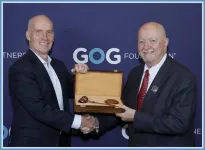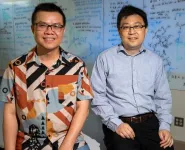(Press-News.org) JUPITER, Fla. — A new scientist joining The Herbert Wertheim UF Scripps Institute for Biomedical Innovation & Technology invents creative and efficient ways to build complex, potentially useful molecules, studying their activity so that compounds found in nature may eventually become useful products, such as medications.
Synthetic chemist and associate professor Masayuki Wasa, Ph.D., joins the institute from Boston College, where he was an assistant professor of chemistry. Synthetic chemists specialize in assembling larger molecules from smaller parts, like a child assembling a Lego spaceship from a basket of oddly shaped pieces.
But the work is far from child’s play, as some pieces cling tightly or resist moving together, requiring feats of physics, mathematics and chemistry to overcome.
Wasa not only invents new systems for assembling important molecules, he carries out in-depth studies that show how some medicinal molecules work, making him a valued colleague, said chemistry department chair and Institute Professor Matthew Disney, Ph.D. Many potential medications fail during clinical trials, so having more complete data about how they would interact within the body is important, he said.
“We are thrilled to have Masa and his students come to our campus. I know that many of the researchers on campus have already initiated collaborative projects with them,” Disney said.
At Boston College, Wasa developed a method for affixing deuterium tags to pharmaceuticals, to enable diagnostic and mechanistic studies of drug candidates. He also designed a chemical tagging strategy for nitrogen-hydrogen bonds commonly seen in natural product-based pharmaceuticals. The work was recently published in the Journal of the American Chemical Society.
“One of the main reasons I wanted to come here was I wanted to do more biologically oriented chemistry,” Wasa said.
Some of the most important medications prescribed by doctors today began as natural substances released from hard-to-find soil microbes or sea sponges. While such compounds have great usefulness, problems of supply and demand, plus manufacturing challenges, would limit their availability — or make them prohibitively expensive — without the talents of expert synthetic chemists.
A 2013 graduate of Scripps Research’s doctoral program, Wasa studied under MacArthur Fellow Jin-Quan Yu, Ph.D. He wrote his thesis on developing new methods to modify otherwise chemically unreactive carbon-hydrogen bonds, by employing complexes of palladium bases. He went on to a postdoctoral fellowship at Harvard University, working with prominent organic chemist Eric N. Jacobsen, Ph.D.
He has won many awards for his contributions. Wasa is a Sloan Fellow and recipient of the National Institutes of Health’s Maximizing Investigators’ Research Award, or MIRA, for Early Stage Investigators. He also received a fellowship from the Japan Society for the Promotion of Science during his postdoctoral work.
Scientific Director Patrick Griffin, Ph.D., called Wasa a stellar addition to the faculty of The Herbert Wertheim UF Scripps Institute for Biomedical Innovation & Technology.
“I am excited that we continue to expand our chemistry faculty, and Dr. Wasa represents an outstanding addition to an already phenomenal team,” Griffin said.
END
At the NRG Oncology Summer Meeting on Thursday, July 20, 2023, at approximately 5:44pm EDT, Larry J. Copeland, MD passed the presidential gavel to Thomas J. Herzog, MD at The GOG Foundation, Inc. (GOG-F) Board of Directors meeting.
Dr. Herzog brings a comprehensive background in clinical trials, the integral business aspects and acumen to this important position. A practicing gynecologic oncologist and member of the Board of Directors of GOG-F, he has served as the Treasurer of GOG-F from 2014-2023 and prior ...
Embargoed for release until 5:00 p.m. ET on Monday 31 July 2023
Annals of Internal Medicine Tip Sheet
@Annalsofim
Below please find summaries of new articles that will be published in the next issue of Annals of Internal Medicine. The summaries are not intended to substitute for the full articles as a source of information. This information is under strict embargo and by taking it into possession, media representatives are committing to the terms of the embargo not only on their own behalf, but also on behalf ...
Declawing house cats to keep them from scratching people and furniture is controversial – and even banned in some countries and areas in the U.S. – but the practice is not limited to house cats. In a new study, researchers looked at the effects of declawing on larger cat species and found that declawing disproportionately impacts their muscular capabilities as compared to their smaller brethren.
While it is illegal in the U.S. to surgically modify an exotic animal, declawing is still done on large cats like lions and tigers, often in an effort to allow cubs to more safely ...
BIRMINGHAM, Ala. – Birmingham’s Pepper Place has a striking new addition to its teeming farmers’ market and noted food offerings — a multimillion-dollar cancer research laboratory.
The lab is IN8bio’s new research and development facility in the Martin Biscuit Building at Pepper Place. This R&D space has about 6,000 square feet of wet lab space and around 4,000 square feet for offices, conferences and break areas. IN8bio is a biotechnology company focused on developing novel cellular therapies for cancer, with deep roots in cutting-edge cancer research developed at ...
Neurons produce rhythmic patterns of electrical activity in the brain. One of the unsettled questions in the field of neuroscience is what primarily drives these rhythmic signals, called oscillations. University of Arizona researchers have found that simply remembering events can trigger them, even more so than when people are experiencing the actual event.
The researchers, whose findings are published in the journal Neuron, specifically focused on what are known as theta oscillations, which emerge in the brain's hippocampus region during activities like exploration, navigation and sleep. The hippocampus plays ...
Every protein in your body is made up of the same 20 building blocks called amino acids. But just because nature is stuck with a limited toolkit doesn’t mean humans can’t expand it.
A study published in Science on July 27 by a team including Pitt chemists describes a powerful new way to create “unnatural” amino acids, which could find use in protein-based therapies and open up novel branches of organic chemistry.
“This is a completely new transformation: new to nature and new to chemistry,” ...
Social media is a critical marketing tool to help raise awareness when firms launch new products. The platforms can help inform consumers about product characteristics and benefits relative to competitors’ products.
New research from the University of Notre Dame analyzes data from the motion picture industry, which often relies on social media promotion, in an effort to understand how marketers could better promote other new products.
“The Ripple Effect of Firm-Generated Content on New Movie Releases,” forthcoming in the Journal of Marketing Research ...
Study Shows New Stroke Surgery Eligibility Criteria May Dramatically Increase Lifesaving Stroke Surgery Rates, with Nationwide Implications
SAN DIEGO—A recent study presented today at the Society of NeuroInterventional Surgery’s (SNIS) 20th Annual Meeting noted that U.S. rates of endovascular thrombectomy, a lifesaving stroke treatment, are projected to increase dramatically based on new criteria.
In the study, endovascular thrombectomy was shown to improve clinical outcomes in patients with large ischemic strokes. This change has the ...
RICHLAND, Wash. – A novel method to extract lignin could help spin wheat straw into gold. Lignin produced using the new method was color-neutral, odorless and homogenous, an advance that could make this carbon-neutral material a more viable candidate for development of high-value products.
Reporting in the Proceedings of the National Academy of Sciences, the Washington State University researchers extracted up to 93% lignin with up to 98% purity from wheat straw, producing a significant amount of material in a uniform way that could make ...
Future therapies to help people live healthy lives for longer could be developed from drugs that release tiny amounts of the gas hydrogen sulfide (H2S), new research has indicated.
A study from the University of Exeter, funded by the US Army and charity The United Mitochondrial Disease Foundation, found that targeting tiny amounts of H2S to specific areas of cells in adult worms using a H2S-releasing molecule called AP39, greatly improved health and activity as they aged. The research, published in PNAS, concludes that targeting ...





